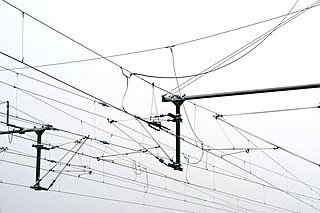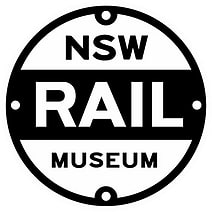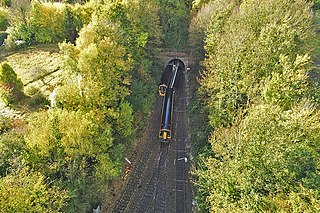Related Research Articles

Rail transport is a means of transport using wheeled vehicles running in tracks, which usually consist of two parallel steel rails. Rail transport is one of the two primary means of land transport, next to road transport. It is used for about 8% of passenger and freight transport globally, thanks to its energy efficiency and potentially high speed.

A train is a series of connected vehicles that run along a railway track and transport people or freight. Trains are typically pulled or pushed by locomotives, though some are self-propelled, such as multiple units or railcars. Passengers and cargo are carried in railroad cars, also known as wagons or carriages. Trains are designed to a certain gauge, or distance between rails. Most trains operate on steel tracks with steel wheels, the low friction of which makes them more efficient than other forms of transport. Many countries use rail transport.

An overhead line or overhead wire is an electrical cable that is used to transmit electrical energy to electric locomotives, electric multiple units, trolleybuses or trams. The generic term used by the International Union of Railways for the technology is overhead line. It is known variously as overhead catenary, overhead contact line (OCL), overhead contact system (OCS), overhead equipment (OHE), overhead line equipment, overhead lines (OHL), overhead wiring (OHW), traction wire, and trolley wire.

A third rail, also known as a live rail, electric rail or conductor rail, is a method of providing electric power to a railway locomotive or train, through a semi-continuous rigid conductor placed alongside or between the rails of a railway track. It is used typically in a mass transit or rapid transit system, which has alignments in its own corridors, fully or almost fully segregated from the outside environment. Third-rail systems are usually supplied from direct current electricity.
Rail transport terms are a form of technical terminology applied to railways. Although many terms are uniform across different nations and companies, they are by no means universal, with differences often originating from parallel development of rail transport systems in different parts of the world, and in the national origins of the engineers and managers who built the inaugural rail infrastructure. An example is the term railroad, used in North America, and railway, generally used in English-speaking countries outside North America and by the International Union of Railways. In English-speaking countries outside the United Kingdom, a mixture of US and UK terms may exist.

The use of a third rail in rail transport modelling is a technique that was once applied, in order to facilitate easier wiring.

The Mersey Railway was the passenger railway connecting the communities of Liverpool, Birkenhead, England. It is currently a part of the Merseyrail network. It was extended further into the Wirral Peninsula, which lies on the opposite bank of the River Mersey to Liverpool. Both sides of the river were connected via the Mersey Railway Tunnel. The railway opened in 1886 with four stations using steam locomotives hauling unheated wooden carriages; in the next six years the line was extended with the opening of three more stations. Using the first tunnel under the Mersey, the line is the world's oldest underground railway outside London.
A wrong-side failure describes a failure condition in a piece of railway signalling equipment that results in an unsafe state. A typical example would be a signal showing a 'proceed' aspect when it should be showing a 'stop' or 'danger' aspect, resulting in a "false clear".

A track circuit is an electrical device used to prove the absence of a train on a block of rail tracks to control railway signals. An alternative to track circuits are axle counters.

An adhesion railway relies on adhesion traction to move the train, and is the most widespread and common type of railway in the world. Adhesion traction is the friction between the drive wheels and the steel rail. Since the vast majority of railways are adhesion railways, the term adhesion railway is used only when it is necessary to distinguish adhesion railways from railways moved by other means, such as by a stationary engine pulling on a cable attached to the cars or by a pinion meshing with a rack.

The NSW Rail Museum is the main railway museum in New South Wales, Australia. A division of Transport Heritage NSW, it was previously known as the New South Wales Rail Transport Museum (NSWRTM), Rail Heritage Centre and Trainworks.

London Underground battery-electric locomotives are battery locomotives used for hauling engineers' trains on the London Underground network where they can operate when the electric traction current is switched off. The first two locomotives were built in 1905 for the construction of the Great Northern, Piccadilly and Brompton Railway, and their success prompted the District Railway to buy two more in 1909, which were the only ones built to the loading gauge of the subsurface lines. Following this, a number of battery vehicles were built by converting redundant motor cars, with the batteries placed in the unused passenger compartment. One exception to this was made by the City and South London Railway, who used a trailer car to hold the batteries, and wired them to a separate locomotive.

3801 is a C38 class 4-6-2 steam locomotive operated by the New South Wales Government Railways between 1943 and 1974. It is arguably Australia's most famous steam locomotive, being the only one to have visited all mainland states and territories.

An axle counter is a system used in railway signalling to detect the clear or occupied status of a specified section of track. The system generally consists of a wheel sensor and an evaluation unit for counting the axles of the train both into and out of the section. They are often used to replace a track circuit.

Slippery rail, or low railhead adhesion, is a condition of railways (railroads) where contamination of the railhead reduces the traction between the wheel and the rail. This can lead to wheelslip when the train is taking power, and wheelslide when the train is braking. One common cause of contamination is fallen leaves that adhere to the railhead of railway tracks. The condition results in significant reduction in friction between train wheels and rails, and in extreme cases can render the track temporarily unusable. In Britain, the situation is colloquially referred to as "leaves on the line".
The railways of New South Wales, Australia have had many incidents and accidents since their formation in 1831. There are close to 1000 names associated with rail-related deaths in NSW on the walls of the Australian Railway Monument in Werris Creek. Those killed were all employees of various NSW railways. The details below include deaths of employees and the general public.
The Marden rail crash occurred on 4 January 1969 near Marden, Kent, United Kingdom, when a passenger train ran into the rear of a parcels train, having passed two signals at danger. Four people were killed and 11 were injured. One person was awarded the British Empire Medal for his part in the aftermath of the collision.

Cowan Bank is an 8.6-kilometre (5 mi) double-track section of the standard gauge Main North line in New South Wales, Australia. It starts at Cowan station, 48.8 kilometres (30 mi) north of Sydney, descending from 200 metres (656 ft) AHD to sea level at Hawkesbury River station. It has an average grade of 2.5%.

The Salisbury Rail Crash was a railway accident on 31 October 2021, at Salisbury, Wiltshire, United Kingdom. Two trains, travelling on converging lines, collided at Salisbury Tunnel Junction, approximately one mile northeast of Salisbury railway station. Fourteen people, including one of the train drivers, were taken to hospital.
References
- ↑ Fellows of Senate: John Manning Ward AO, Memorial Service, http://sydney.edu.au/senate/Ward_memorial.shtml, Retrieved 17 February 2013
- ↑ Pearce, Kenn (1999). Australian railway disasters (2nd ed.). IPL Books. ISBN 978-0-908876-09-9.
- "1990, May 6, Cowan rail emergency". Emergency Management NSW. Archived from the original on 2 October 2013. Retrieved 15 September 2010.
- "RAIL SAFETY ACT 1993 NEW SOUTH WALES" . Retrieved 15 September 2010.